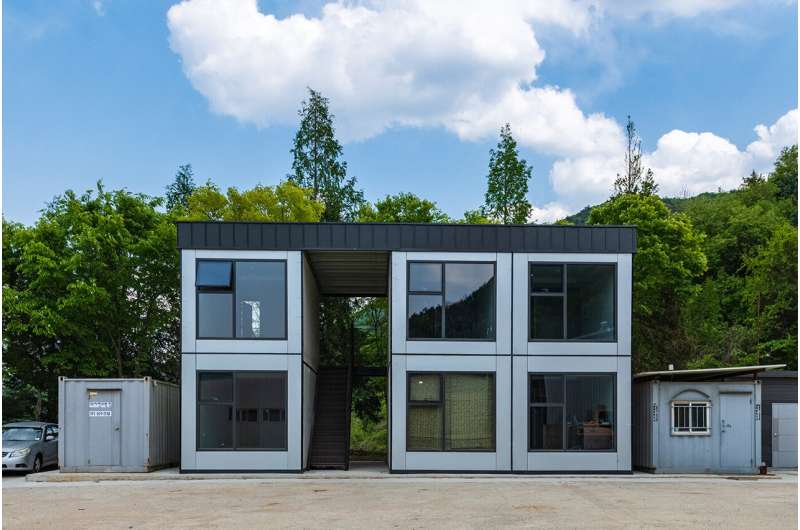This article has been reviewed according to Science X's editorial process and policies. Editors have highlighted the following attributes while ensuring the content's credibility:
fact-checked
trusted source
proofread
Korean researchers develop new modular construction technology

The Korea Institute of Civil Engineering and Building Technology (KICT) researchers have developed a new modular construction method capable of building structures by assembling modular components within a short time, particularly in cases of emergencies or disasters.
The modular construction method involves fabricating about 70% to 80% of the major members and components of the target structure in factories in advance and then transporting them to the construction site to complete the construction with simple assembly and installation processes. This method is differentiated from conventional field operation-oriented construction methods.
This novel method is increasingly recognized as a key construction solution for the future across the globe thanks to its significant contribution to addressing the risk of safety accidents while reducing construction periods.
Compared to conventional construction methods, this approach generates less noise, dust, and waste, and modular components used in this method can be recycled or repurposed later, contributing to the promotion of environmental, social, and governance (ESG) management.
The new modular construction method developed by a research team from KICT (Dr. Lim, Seok-Ho and Dr. Chung, Joon-Soo) is suitable for use in structures in which a box-type infill module whose floor, inner walls, and roof are prefabricated in a factory is plugged in a U-shaped PC module with a wall-type load-bearing structure.
The U-shaped PC module includes a floor and two side walls, and the infill module is inserted through its upper opening. Modules are prefabricated in a factory and simply assembled at the construction site, leading to a faster and more straightforward construction process.
The method developed by Dr. Lim, Seok-Ho's research team allows for the straightforward assembly of infill modules by lifting them up and placing them down into the target U-shaped PC module using a crane, thereby eliminating the need to use separate vehicles to move them. Moreover, its plug-in assembly method, in which modules are lifted up and placed down into the target modules, contributes to enhanced constructability.
The detailed procedure of the developed modular construction method is as follows:
- Install PC modules
- Insert box-type infill modules and lift up and stack the integrated sets of PC modules and infill modules
- Install roofing
- Install stairs and corridors
The developed technology not only reduces construction periods but also enables easy installation and disassembly through plug-in assembly, in contrast to conventional construction methods that rely on on-site operations using cast-in-place concrete and steel modular frames. Moreover, this approach results in reduced self-load and work volume because modules are stacked in a single slab mode.
Additionally, the use of a fire-resistant concrete structure eliminates the necessity for external finishing operations. More importantly, optioning for PC modules prefabricated in a factory as an alternative to steel frames, along with infill modules that require no on-site operations, including interior finishing, enhances both cost-effectiveness and constructability simultaneously.
In 2023, the Korean Ministry of Land, Infrastructure and Transport announced a blueprint for promoting the use of the modular construction method not only in new rental houses within the Seoul Metropolitan area but also in third-generation new towns, with the aim of accelerating housing supply. In line with this development, new orders in Korea's modular construction market are expected to increase from 800 billion won in 2019 to 2.4 trillion won by 2024.
The new modular construction technology developed by KICT is considered to meet the needs of the Korean government for expanding the housing supply while effectively accommodating the expected increase in new orders in the market. Not only that, structures built by this method can be easily disassembled later, when necessary, in the reverse order of the assembly procedure.
The disassembled modules can be recycled or repurposed, constituting a genuine resource circulation system for production. This technology is expected to find applications in various fields, with potential uses ranging from negative pressure hospital rooms for infectious disease prevention and military bases or barracks to houses for less privileged people, as well as for export purposes.
Dr. Lim, Seok-Ho said, "The developed modular construction method will offer effective solutions for addressing environmental issues in the construction industry and housing shortages. Conventional methods using steel modules are deemed less cost-effective compared to concrete construction methods."
"In contrast, this technology significantly reduces construction costs and diminishes the need for a large portion of on-site operations, resulting in shorter construction periods compared to conventional concrete construction methods, all thanks to the mass production of repeated sets of necessary modules."

















